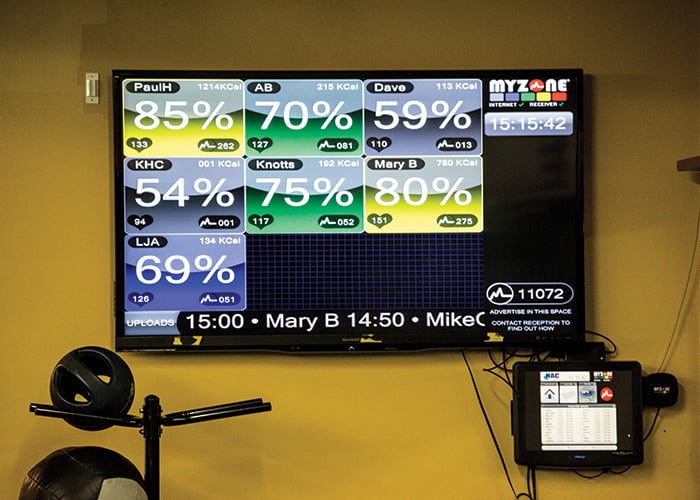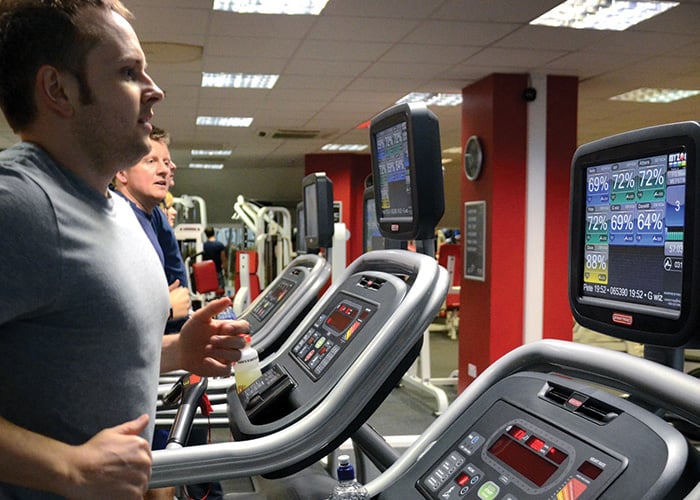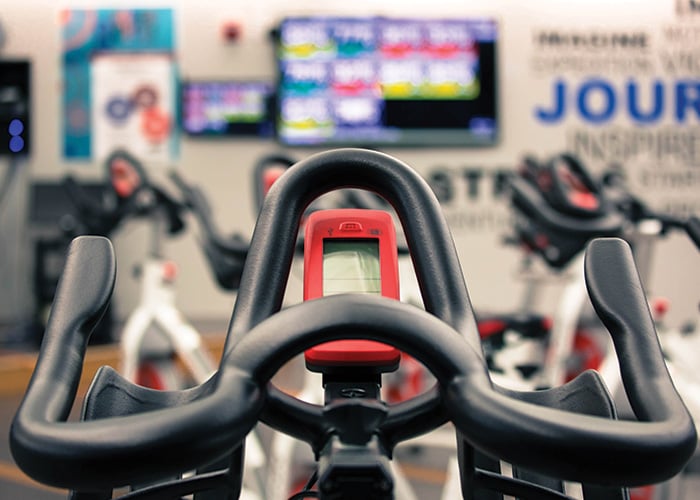How to Monitor Your Clients’ Training Progress
One of our tasks as trainers is to track the progress of our clients. When it comes to workout tracking, there are many ways in which we can do it. This blog post will cover four assessments you can use to measure improvements in the cardiorespiratory fitness of your clients using the MYZONE heart rate monitor system. For each method of assessment, recommendations will be provided for protocol and frequency.

Assessment #1: Resting Heart Rate
As your client’s cardiorespiratory fitness improves, their resting heart rate should decrease as a sign of the improved efficiency of their heart.
Protocol: Instruct your client to wear their MYZONE belt right away when they wake up in the morning for 5-10 minutes. Suggest to your client that they leave their MYZONE belt by the side of their bed with a glass of water. Right when they wake up in the morning, they should put their belt on and slightly wet down the electrodes on the sides of the transmitter against their skin. Once they hear their belt beep once to indicate that it is recording their heart rate, they should stay lying down in bed with the belt on for 5-10 minutes. They can monitor their resting heart rate using the MYZONE App, and you can view their resting heart rate on the owner’s page. Your client’s resting heart rate will automatically update in the system when it drops lower than previously recorded.
Frequency: Perform this assessment at the beginning of your client’s training program and every four to eight weeks as a follow up assessment. You could expect to see your client’s resting heart rate come down five to ten beats per minute every four to eight weeks during regular training. Eventually, your client’s resting heart rate will level off. A healthy resting heart rate ranges between 60 beats per minute and 75 beats per minute. Highly fit individuals who regularly train their cardiorespiratory system may have resting heart rates as low as 40 beats per minute or lower.

Assessment #2: Rate of Perceived Exertion (RPE)
Rate of perceived exertion is your client’s perception of their overall effort during exercise. Typically a scale of one to ten is used with one equating to a very light effort and ten equating to a very, very hard effort.
Protocol: While your client is exercising and wearing their MYZONE belt, you can check in with their subjective or perceived intensity (RPE) while you monitor their objective intensity (percentage of maximum heart rate).
Check in with your client while they are in various intensity zones to gauge their subjective intensity relative to the zone they are in. For example, while your client is warming up in the blue or green zones, ask them their overall perception of their effort on a scale of one to ten with one being a very light intensity (like casually walking) and ten being very, very hard (like on the verge of passing out). Repeat this same assessment when your client is in the yellow or red zone. Keep track of how your client’s RPE compares to the various zones throughout different workouts.
Over time, your client’s RPE may decrease while they are working at the same workload (i.e. at the beginning of their program, they might feel like a seven out of ten when running at 6.5 mph on the treadmill at .5% incline, but after several months, they might report feeling like a five out of ten).
Frequency: Perform the RPE assessment with your client every two to four weeks when they are working at the same or similar workloads. Monitor which heart rate zone they are in (blue, green, yellow, or red) and record their corresponding RPE. You can compare across time how your client’s subjective RPE relates to their objective heart rate zones.
You should expect that as your client’s fitness improves, both their heart rate and RPE at the same workload would decrease. For example, at the beginning of your client’s training program, they might be in the yellow zone and report an eight out of ten when running on the treadmill at 6.5 mph and .5% incline. After several months of training, your client is likely to stay in the green zone and report a six out of ten when running at the same workload.

Assessment #3: Heart Rate Recovery
Heart rate recovery refers to the amount of time it takes your client’s heart rate to recover down to a lower intensity (gray, blue, green) after a higher intensity effort (yellow, red). A faster heart rate recovery is an indication of improved efficiency of the cardiorespiratory system.
Protocol: After a solid warm up in the blue and green zones, cue your client to take their heart rate up into the yellow zone and hold for a minute or two. You can use any modality of cardio that you and your client choose–just keep it consistent as you perform follow up assessments.
Check in with your client’s rate of perceived exertion (RPE) as you monitor their ascent into the yellow zone and as they hold in yellow. After a minute or two in the yellow zone, instruct your client to decrease their workload and begin an active recovery (very light workload) back into the blue zone. Record the time it takes your client’s heart rate to descend from yellow to blue.
Frequency: Perform this assessment at the beginning of your client’s training program and every eight to twelve weeks. Keep the modality of the assessment consistent as well as the duration you have them hold in the yellow zone before recovering to blue.
After performing cardiorespiratory training for eight to twelve weeks, your client’s heart rate should recover faster from yellow down to blue.
We suggest making this assessment relative to your client, meaning there is no “bad” or “good” amount of time for the recovery. Rather, you would want to look for faster and faster recovery from your client each time you perform the assessment. For example, if it takes your client three minutes to recover from yellow to blue during the initial assessment, an improvement would be for the recovery to take only two minutes at a follow up assessment.

Assessment #4: Submaximal Heart Rate
As our cardiorespiratory fitness improves, it is actually more and more challenging for us to elevate our heart rate into the yellow and red zones (submaximal intensity zones). Therefore, as your client becomes more and more fit, they will actually have to work at more challenging workloads to bring their heart rate up. A previous workload that once caused them to get their heart rate up into the yellow zone might only elevate their heart rate into the green zone after training.
Protocol*: For this assessment, pick a particular mode of cardio (i.e. treadmill, elliptical, or cycle) and have your client exercise at a prescribed workload for five to ten minutes (following a warm-up of course). For example, have your client on the elliptical at a resistance of seven out of ten, an incline of five out of ten, and maintaining 70 rotations per minute (rpm). Assess which zone they spend each minute in (green, yellow, etc.).
During your follow up assessments, monitor if your client’s submaximal heart rate changes in response to the same stimulus/workload (i.e. maybe they only get into the green rather than the yellow).
After several follow up assessments with similar results, try increasing the workload slightly and see if your client’s heart rate goes up.
*This assessment pairs nicely with the rate of perceived exertion (RPE) assessment.
Frequency: Perform this assessment at the beginning of your client’s training program and every four to eight weeks. You are looking for any changes in your client’s submaximal heart rate when they are exercising at the same workload as a prior assessment.
As your client’s fitness level improves, you can increase the workload for the following assessment. Over time, you should see via the MYZONE heart rate monitoring system, that your client has to work at an increasingly challenging workload to get their heart rate up into the yellow and red zones.
Follow our MYZONE Master Trainers on our Fitness Friday Periscope Broadcast for more tips on fitness assessments. We would love to follow the progress of your clients with you. Please post (and have your clients post) to Facebook, Twitter, and Instagram using the hashtags: #myzone #myzonemoves #effortrewarded.
Keep Moving Forward!
Share this
You May Also Like
These Related Stories

Heart Rate Recovery Assessment

Get Clients Started with Myzone: Submaximal Assessment



